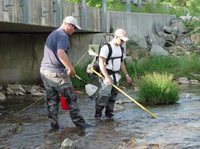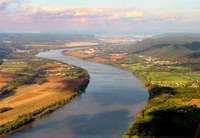Ohio River Basin Fish Habitat Partnership
|
The Ohio River Basin Fish Habitat Partnership (ORBFHP) was formed to protect, restore, and enhance priority habitat for fish and mussels in the watersheds of the Ohio River Basin. They pursue this mission for the benefit of the public and the diverse basin itself. The partnership encompasses the entire 981 miles of the Ohio River mainstem (the second largest river in the U.S. as measured by annual discharge) and 143,550 square miles of the watershed. Whether it is sport fish, mussels, imperiled fish, water quality, or one of many other drivers, the ORBFHP works together to protect, restore, and enhance the Basin's aquatic resources. |
|
The Ohio River Basin FHP and Appalachian LCCThe ORBFHP is one of 5 major aquatics partnerships that have some portion of their range within the Appalachian LCC. To date, the Appalachian LCC has participated in several conference calls and meetings to develop ways of integrating resources and sharing information with this regional partnership. At the most recent ORBFHP meeting, LCC Staff provided an overview of the Cooperative's recent activities, discussed collaboration opportunities, and offered assistance to showcase the work and projects of the ORBFHP via a potential companion website. Ohio River Basin FHP Overview and Strategy The FHP Overview and Strategy presentation provides a general overview of the ORBFHP. It includes information on the regional partnership's mission, the region in which they are targeting their conservation work, the types of rivers and streams they are focusing on, and the strategies they are using to combat threats to the Basin. The FHP Overview and Strategy presentation provides a general overview of the ORBFHP. It includes information on the regional partnership's mission, the region in which they are targeting their conservation work, the types of rivers and streams they are focusing on, and the strategies they are using to combat threats to the Basin.Training OpportunityDesigning for Aquatic Organism Passage at Road-Stream Crossings This course will provide engineers, biologists, hydrologists, and other engaged disciplines the necessary skills to design road-stream crossing structures that will accommodate aquatic organism passage, provide for more natural channel function, and maximize the long-term stability of the structure. The primary design approach is stream simulation. It will take place in Capon Springs, West Virginia May 13-17, 2013. |
Purpose and Accomplishments
Fish and mussel habitat within the Ohio River Basin is imperiled by a number of historic impacts and continuing threats including mineral extraction, row crop agriculture, and livestock grazing. It was within this context that a group of approximately 50 representatives from state and federal agencies, NGOs and universities within the Ohio River Basin initially coalesced into the candidate Ohio River Basin Fish Habitat Partnership. For More InformationVisit National Fish Habitat Partnership website. Contact: |


 The partnership encompasses the entire 981 miles of the Ohio River mainstem (the second largest river in the U.S. as measured by annual discharge) and 143,550 square miles of the watershed. The Ohio River drainage contains at least 350 species of fish ranging from endemic darters and dace in the headwaters to a suite of great river fish (e.g., paddlefish, blue sucker, lake sturgeon, and shovelnose sturgeon) and more than 120 mussel species, including a number that are federally listed. These figures approach half of the freshwater fishes and over a third of all mussel species found in the United States. A number of the rivers in the Ohio River Basin also support outstanding smallmouth or spotted bass angling.
The partnership encompasses the entire 981 miles of the Ohio River mainstem (the second largest river in the U.S. as measured by annual discharge) and 143,550 square miles of the watershed. The Ohio River drainage contains at least 350 species of fish ranging from endemic darters and dace in the headwaters to a suite of great river fish (e.g., paddlefish, blue sucker, lake sturgeon, and shovelnose sturgeon) and more than 120 mussel species, including a number that are federally listed. These figures approach half of the freshwater fishes and over a third of all mussel species found in the United States. A number of the rivers in the Ohio River Basin also support outstanding smallmouth or spotted bass angling.



















